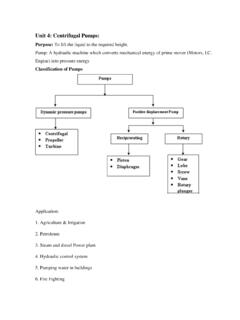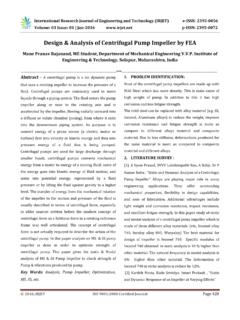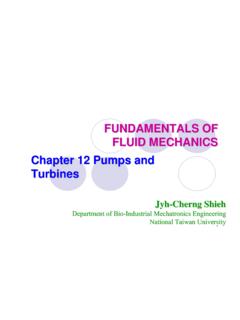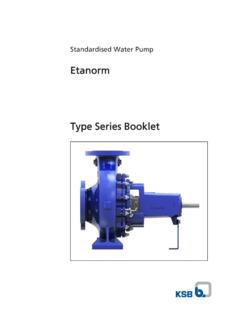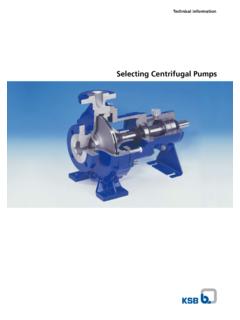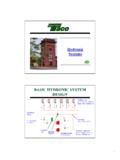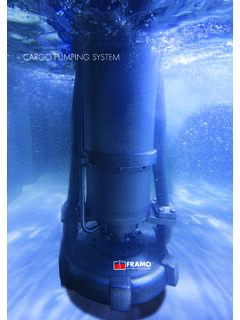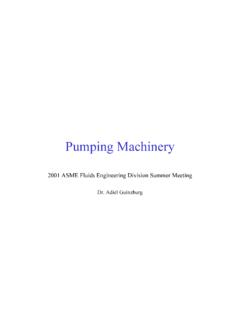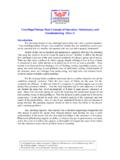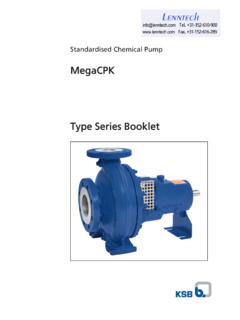Transcription of Collection Systems Technology Fact Sheet: Sewers, Lift Station
1 United StatesEnvironmental ProtectionAgencyOffice of WaterWashington, 832-F-00-073 September 2000 Collection SystemsTechnology Fact SheetSewers, Lift StationDESCRIPTIONW astewater lift stations are facilities designed tomove wastewater from lower to higher elevationthrough pipes. Key elements of lift stations includea wastewater receiving well (wet-well), oftenequipped with a screen or grinding to removecoarse materials; pumps and piping with associatedvalves; motors; a power supply system; anequipment control and alarm system; and an odorcontrol system and ventilation Station equipment and Systems are ofteninstalled in an enclosed structure.
2 They can beconstructed on-site (custom-designed) or pre-fabricated. Lift Station capacities range from76 liters per minute (20 gallons per minute) to morethan 378,500 liters per minute (100,000 gallons perminute). Pre-fabricated lift stations generally havecapacities of up to 38,000 liters per minute (10,000gallons per minute). centrifugal pumps arecommonly used in lift stations. A trapped aircolumn, or bubbler system, that senses pressure andlevel is commonly used for pump Station control alternatives include electrodes placedat cut-off levels, floats, mechanical clutches, andfloating mercury switches.
3 A more sophisticatedcontrol operation involves the use of variable speeddrives. Lift stations are typically provided with equipmentfor easy pump removal. Floor access hatches oropenings above the pump room and an overheadmonorail beam, bridge crane, or portable hoist arecommonly used. The two most common types of lift stations are thedry-pit or dry-well and submersible lift stations. Indry-well lift stations, pumps and valves are housedin a pump room (dry pit or dry-well), that is easilyaccessible. The wet-well is a separate chamberattached or located adjacent to the dry-well (pumproom) structure.
4 Figures 1 and 2 illustrate the twotypes of lift stations do not have a separatepump room; the lift Station header piping,associated valves, and flow meters are located in aseparate dry vault at grade for easy lift stations include sealed pumps thatoperate submerged in the wet-well. These areremoved to the surface periodically and reinstalledusing guide rails and a hoist. A key advantage ofdry-well lift stations is that they allow easy accessfor routine visual inspection and maintenance.
5 Ingeneral, they are easier to repair than submersiblepumps. An advantage of submersible lift stations isthat they typically cost less than dry-well stationsand operate without frequent pump lift stations do not usually includeDry WellWet WellInletHoistDischargeSource: Qasim, 1 DRY-WELL PUMP large aboveground structures and tend to blend inwith their surrounding environment in residentialareas. They require less space and are easier andless expensive to construct for wastewater flowcapacities of 38,000 liters per minute (10,000gallons per minute) or less.
6 APPLICABILITYLift stations are used to move wastewater fromlower to higher elevation, particularly where theelevation of the source is not sufficient for gravityflow and/or when the use of gravity conveyancewill result in excessive excavation depths and highsewer construction StatusLift stations are widely used in wastewaterconveyance Systems . Dry-well lift stations havebeen used in the industry for many years. However,the current industry-wide trend is to replace dry-well lift stations of small and medium size(typically less than 24,000 liters per minute or 6,350gallons per minute)
7 With submersible lift stationsmainly because of lower costs, a smaller footprint,and simplified operation and speed pumping is often used to optimizepump performance and minimize power types of variable-speed pumping equipmentare available, including variable voltage andfrequency drives, eddy current couplings, andmechanical variable-speed drives. Variable-speedpumping can reduce the size and cost of the wet-well and allows the pumps to operate at maximumefficiency under a variety of flow variable-speed pumping allows lift stationdischarge to match inflow, only nominal wet-wellstorage volume is required and the well water levelis maintained at a near constant pumping may allow a given flowrange to be achieved with fewer pumps than aconstant-speed alternative.
8 Variable-speed stationsalso minimize the number of pump starts and stops,reducing mechanical wear. Although there issignificant energy saving potential for stations withlarge friction losses, it may not justify the additionalcapital costs unless the cost of power is relativelyhigh. Variable speed equipment also requires moreroom within the lift Station and may produce morenoise and heat than constant speed pumps . Lift stations are complex facilities with manyauxiliary Systems . Therefore, they are less reliablethan gravity wastewater conveyance.
9 However, liftstation reliability can be significantly improved byproviding stand-by equipment ( pumps and controls)and emergency power supply Systems . In addition,lift Station reliability is improved by using non-clogpumps suitable for the particular wastewater qualityand by applying emergency alarm and automaticcontrol Systems . ADVANTAGES AND DISADVANTAGESA dvantagesLift stations are used to reduce the capital cost ofsewer system construction. When gravity sewersare installed in trenches deeper than three meters(10 feet), the cost of sewer line installationincreases significantly because of the more complexand costly excavation equipment and trench shoringtechniques required.
10 The size of the gravity sewerlines is dependent on the minimum pipe slope andflow. Pumping wastewater can convey the sameflow using smaller pipeline size at shallower depth,and thereby, reducing pipeline costs. HoistDischargeSource: Qasim, 2 WET-WELL SUBMERSIBLED isadvantagesCompared to sewer lines where gravity driveswastewater flow, lift stations require a source ofelectric power. If the power supply is interrupted,flow conveyance is discontinued and can result inflooding upstream of the lift Station , It can alsointerrupt the normal operation of the downstreamwastewater conveyance and treatment limitation is typically addressed by providingan emergency power supply.










